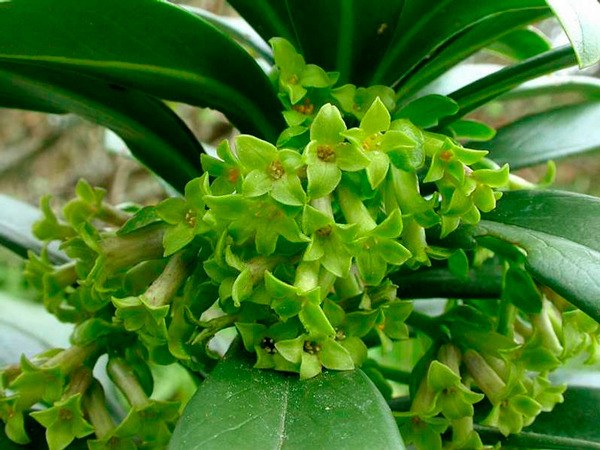
— Submitted by San Juan County Noxious Weed Control Program
That evergreen, rhododendron-like shrub that is popping up in gardens and woodlands throughout the county is spurge laurel (Daphne laureola). Closely related to the much-admired ornamental daphnes, all parts of this plant are toxic to dogs, cats and humans and contact with the sap may cause mild to severe dermatitis. Beyond the issue of toxicity, spurge laurel is highly invasive.
Unlike many other invasive plants, seeds of spurge laurel do not require the ground to be disturbed in order to set down roots. Primarily spread by rodents and birds, seeds are being carried long distances to infest forests, county parks (more than 758 plants were removed from San Juan Park in 2013), recreational areas (AmeriCorps volunteers have removed may thousands of plants from Camp Four Winds in Deer Harbor), National Parks, Bureau of Land Management lands and outer island wildlife refuges.
Shade tolerant, it easily out-competes the native forest understory flora, altering natural plant succession and forming dense monocultures. Its deep shade of green and native appearance can make spotting it difficult, particularly when it is growing in salal-rich understories. Several Gulf islands of British Columbia have had over 40 percent of their forest floor overtaken with these shrubs.
It is a long-lived, woody perennial that grows to four or more feet in height. Its shiny leaves are spirally arranged and concentrated towards the tips of the stems. The small, yellowish-green flowers appear in late winter or early spring, clustered in the leaf axils. These fragrant flowers have no petals but have four sepals. The toxic, egg-shaped berries are green, turning blue-black as they ripen in early summer.
Fall, winter, and early spring are optimal seasons to uproot these invasive plants, when the soil is moist and there are no ripe berries on the plants, thus reducing its spread by seed. Locating these evergreen shrubs is easier when the surrounding vegetation has lost its deciduous leaves. Seedlings and young shrubs can be pulled by hand or with a weed wrench, available on loan from Public Works, the Land Bank, the National Park Service or the Noxious Weed Program. Remove as much of the root as possible, since younger shrubs may resprout. Cutting older shrubs at the base when they are drought-stressed, are in flower, or its seeds are unripe, (green) will help reduce regrowth. Cutting shrubs a few inches below the soil line will also increase the odds of mortality. Applying a systemic herbicide with a foam brush immediately to cut stubs is another control option.
Due to the toxicity of the plant, wear gloves. Special care should be taken to avoid getting the sap in your eyes. Avoid transporting plants in a closed vehicle, as airborne Daphne toxins can concentrate in an unventilated space and cause nausea and eye and throat irritation. Pulled shrubs can be piled and be left on site with their roots exposed to desiccate.
Because of its toxicity and the environmental damage caused by this species, both the State of Washington and San Juan County have classified it as a Class B noxious weed, which means that it must be, by law, controlled and prevented from spreading by the property owner (RCW 17.10 and WAC 16-750), and, since noxious weeds are considered a property defect, their presence should be disclosed by a seller at the time of sale. For more information on spurge laurel or other noxious weeds, contact the San Juan County Noxious Weed Control Program at 376-3499.


